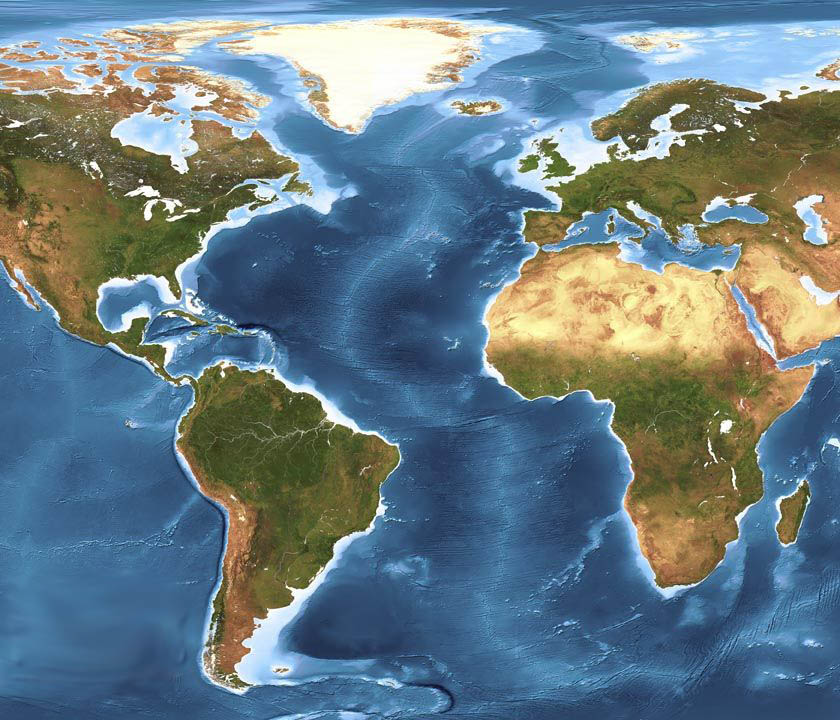

The Mid-Atlantic Ridge (MAR) is a mid-ocean ridge, a divergent tectonic plate boundary located along the floor of the Atlantic Ocean, and the longest mountain range in the world. It separates the Eurasian Plate and North American Plate in the North Atlantic, and the African Plate from the South American Plate in the South Atlantic. The Ridge extends from a junction with the Gakkel Ridge (Mid-Arctic Ridge) northeast of Greenland southward to the Bouvet Triple Junction in the South Atlantic. Although the Mid-Atlantic Ridge is mostly an underwater feature, portions of it have enough elevation to extend above sea level. The section of the ridge which includes the island of Iceland is also known as the Reykjanes Ridge. Read more ...

A powerful earthquake on one ridge can affect them all.
A ridge under the Atlantic Ocean was first inferred by Matthew Fontaine Maury in 1850. The ridge was discovered during the expedition of HMS Challenger in 1872. A team of scientists on board, led by Charles Wyville Thomson, discovered a large rise in the middle of the Atlantic while investigating the future location for a transatlantic telegraph cable. The existence of such a ridge was confirmed by sonar in 1925 and was found to extend around the Cape of Good Hope into the Indian Ocean by the German Meteor expedition.
In the 1950s, mapping of the Earth's ocean floors by Bruce Heezen, Maurice Ewing, Marie Tharp and others revealed the Mid-Atlantic Ridge to have a strange bathymetry of valleys and ridges, with its central valley being seismologically active and the epicentre of many earthquakes. Ewing and Heezen discovered the ridge to be part of a 40,000-km-long essentially continuous system of mid-ocean ridges on the floors of all the Earth's oceans. The discovery of this worldwide ridge system led to the theory of seafloor spreading and general acceptance of Wegener's theory of continental drift and expansion as plate tectonics.

The ridge sits atop a geologic feature known as the Mid-Atlantic Rise which is a progressive bulge that runs the length of the Atlantic Ocean, with the ridge resting on the highest point of this linear bulge. This bulge is thought to be caused by upward convective forces in the asthenosphere pushing the oceanic crust and lithosphere.
This divergent boundary first formed in the Triassic period when a series of three-armed grabens coalesced on the supercontinent Pangaea to form the ridge. Usually only two arms of any given three-armed graben become part of a divergent plate boundary. The failed arms are called aulacogens, and the aulacogens of the Mid-Atlantic Ridge eventually became many of the large river valleys seen along the Americas and Africa (including the Mississippi River, Amazon River and Niger River). The ridge is about 2,500 meters (8,200 ft) below sea level, while its flank is about 5,000 metres deeper. The Fundy Basin on the Atlantic coast of North America between New Brunswick and Nova Scotia in Canada is evidence of the ancestral Mid-Atlantic Ridge.
The Mid-Atlantic Ridge includes a deep rift valley which runs along the axis of the ridge along nearly its entire length. This rift marks the actual boundary between adjacent tectonic plates, where magma from the mantle reaches the seafloor, erupting as lava and producing new crustal material for the plates. Near the equator, the Mid-Atlantic Ridge is divided into the North Atlantic Ridge and the South Atlantic Ridge by the Romanche Trench, a narrow submarine trench with a maximum depth of 7,758 m (25,453 ft), one of the deepest locations of the Atlantic Ocean. This trench, however, is not regarded as the boundary between the North and South American Plates, nor the Eurasian and African Plates. Read more
The islands, from north to south, with their respective highest peaks and location, are:
Northern Hemisphere (North Atlantic Ridge):
Iceland through which the ridge runs
Azores (Ponta do Pico or Pico Alto, on Pico Island)
Bermuda was formed on the ridge, but is now considerably west of it
Saint Peter and Paul Rocks
Southern Hemisphere (South Atlantic Ridge):
Tristan da Cunha (Queen Mary's Peak)
Gough Island (Edinburgh Peak)
Bouvet Island
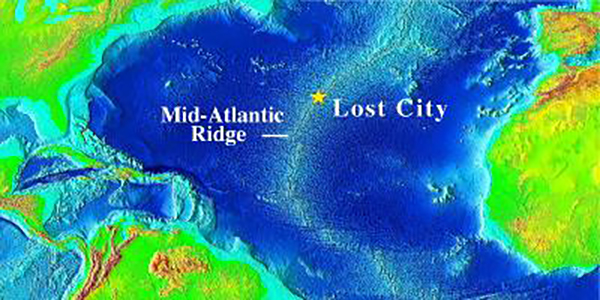
There's a 'Lost City' Deep in The Ocean, And It's Unlike Anything We've Ever Seen

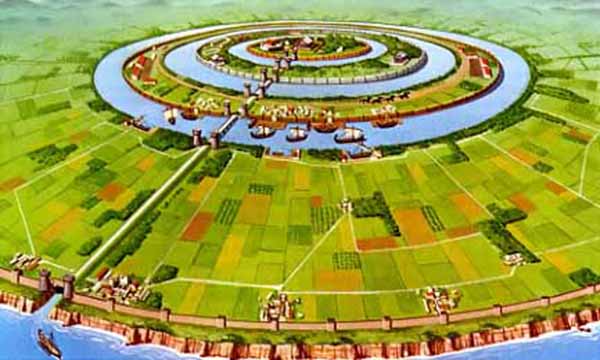
I always pay attention to the Mid-Atlantic Ridge as a precursor for end times. Most people follow increasing earthquake activity in the Pacific as well as the recently split Indian Ocean Plate but I live on the Atlantic seaboard and this is what rings true for me.
The bottom line is all of the tectonic plates are broken so it's just a matter of time until the first 'domino' falls as the others follow suit.
This takes us to Atlantis and a prophecy about Atlantis Rising at the end of time. Whether Atlantis was a myth or a UFO (UAP) - may never be known.
A strong and shallow 6.6 earthquake hit central Mid-Atlantic Ridge Watchers - March 28, 2025

At the same time this happened
March 28, 2025 - Myanmar 7.7 Earthquake Wikipedia - March 28, 2025
Marker for the collapse of key Atlantic current discovered Live Science - February 9, 2024
A vital Atlantic current that includes the Gulf Stream and keeps our climate in check may be giving off a warning sign of collapse.
Very strong mag. 6.2 earthquake - South Atlantic Ocean Volcano Discovery - October 10, 2022
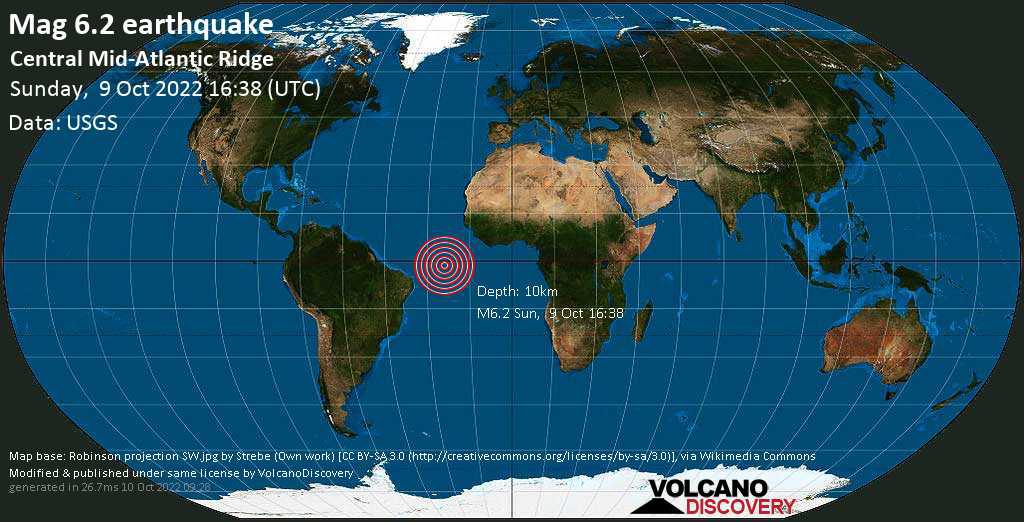
The Atlantic Ocean is widening. Here's why. Live Science - January 28, 2021
The Atlantic Ocean is getting wider, shoving the Americas to one side and Europe and Africa to the other. But it's not known exactly how. A new study suggests that deep beneath the Earth's crust, in a layer called the mantle, sizzling-hot rocks are rising up and pushing on tectonic plates - those rocky jigsaw pieces that form Earth's crust - that meet beneath the Atlantic. Previously, scientists thought that the continents were mostly being pulled apart as the plates beneath the ocean moved in opposite directions and crashed into other plates, folding under the force of gravity. But the new study suggests thatŐs not the whole picture. The research began in 2016, when a group of researchers set sail on a research vessel to the widest part of the Atlantic Ocean between South America and Africa; in other words, to the middle of nowhere.
Moderate mag. 5.9 earthquake - Northern Mid Atlantic Ridge Volcano Discovery - October 30, 2020
Moderate mag. 5.6 earthquake - Northern Mid-Atlantic Ridge Volcano Discovery - October 6, 2020
5.8 earthquake - Central Mid Atlantic Ridge Volcano Discovery - September 24, 2020
Strong mag.6.9 earthquake in the central mid-Atlantic ridge widens the Atlantic ocean a bit Volcano Discovery - September 19, 2020
Strong mag. 6.6 earthquake - Central Mid Atlantic Ridge on Sunday, September 6, 2020 Volcano Discovery - September 6, 2020
Strong mag. 6.5 earthquake - Central Mid Atlantic Ridge Volcano Discovery - August 30, 2020
6.2 magnitude earthquake hits northern Mid-Atlantic Range Business Standard - February 15, 2019

An earthquake measuring 6.2 on the Richter Scale struck northern Mid-Atlantic Range region. The quake hit at a depth of 10 km and took place at 7:57 pm, according to United States Geological Survey (USGS). No tsunami warning has been issued so far. The Mid-Atlantic Ridge is a mid-ocean ridge located along the floor of the Atlantic Ocean. In the North Atlantic, the ridge separates the Eurasian and North American plates, and in the South Atlantic, it separates the African and South American plates.
A magnitude 4.1 earthquake struck Thursday afternoon near Dover, Delaware, and was felt from New York to Baltimore CNN - November 30, 2017
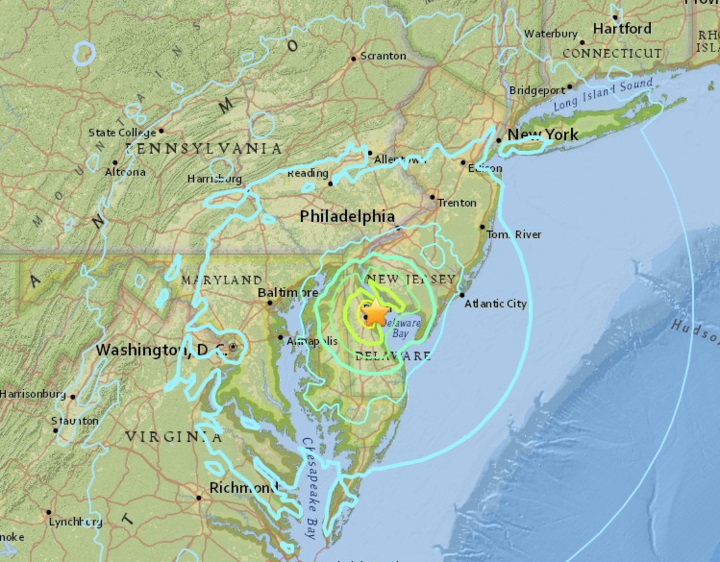
LA PALMA CANARY ISLAND THEORY